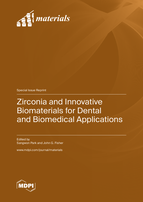Zirconia and Innovative Biomaterials for Dental and Biomedical Applications
A special issue of Materials (ISSN 1996-1944). This special issue belongs to the section "Biomaterials".
Deadline for manuscript submissions: closed (20 March 2023) | Viewed by 23485
Special Issue Editors
Interests: zirconia 3D printing; glass infiltration; implant surface interface; bone tissue engineering; digital dentistry
Interests: piezoelectric materials; single crystal growth; sintering and grain growth behaviour; zirconia dental materials
Special Issues, Collections and Topics in MDPI journals
Special Issue Information
Dear Colleagues,
This Special Issue focuses on the recent trends in zirconia and innovative biomaterials for dental and biomedical applications. The use of zirconia in the biomedical field was initiated in the early 1970s, and the application of zirconia as a prosthetic material in dental-related applications unlocked in the 1990s. Very recently, many scholars established the use of zirconia in the dental and biomedical field as an implant and as the scaffold. Thus, zirconia and zirconia-based materials have a wide range of applications in the biomedical and dentistry fields owing to their excellent mechanical properties, aesthetics, and biocompatibility. This issue critically explores the art and state of zirconia surface treatments (mechanical/chemical/physical), which are a significant challenge in implantology in designing implant biomaterial using advanced technologies which have evolved rapidly to enrich the biological and osteointegration process of dental implants. The surface characteristics are proposed to improve the capacity of anchorage into the bone that determines the long-term clinical success rate. Besides, digital technology (CAD/CAM and 3D printing) in dentistry plays a crucial role in the fabrication of dental restorations and prostheses because of its efficient manufacturing process with high accuracy in a short time. The perfectibility of technology and the suitability of materials are considered as the ultimate requisite for the future.
With an increase in the age-related pathologies and the associated illnesses worldwide, there is a necessity for the advancement of biomaterials to substitute the tissue loss and to boost regenerative mechanisms, as well as to ensure the healing process. Bioceramics, polymers, and metals are such materials that have been used to repair and restore the bone and dental defects, especially for the reconstruction/regeneration of hard tissues. To achieve three-dimensional tissue regeneration, the porous scaffold with multifunctional properties was fabricated using additive manufacturing and conventional techniques. In the area of hard tissue engineering, developing porous synthetic substitutes with faster and wider vascularization properties within their structure is recognized to be an auspicious venue for research.
The extensive range of this Special Issue “Zirconia and innovative biomaterials for dental and biomedical applications” offers an admirable opportunity to submit full papers, short communications, or review papers.
Prof. Dr. Sangwon Park
Prof. Dr. John G. Fisher
Guest Editors
Manuscript Submission Information
Manuscripts should be submitted online at www.mdpi.com by registering and logging in to this website. Once you are registered, click here to go to the submission form. Manuscripts can be submitted until the deadline. All submissions that pass pre-check are peer-reviewed. Accepted papers will be published continuously in the journal (as soon as accepted) and will be listed together on the special issue website. Research articles, review articles as well as short communications are invited. For planned papers, a title and short abstract (about 100 words) can be sent to the Editorial Office for announcement on this website.
Submitted manuscripts should not have been published previously, nor be under consideration for publication elsewhere (except conference proceedings papers). All manuscripts are thoroughly refereed through a single-blind peer-review process. A guide for authors and other relevant information for submission of manuscripts is available on the Instructions for Authors page. Materials is an international peer-reviewed open access semimonthly journal published by MDPI.
Please visit the Instructions for Authors page before submitting a manuscript. The Article Processing Charge (APC) for publication in this open access journal is 2600 CHF (Swiss Francs). Submitted papers should be well formatted and use good English. Authors may use MDPI's English editing service prior to publication or during author revisions.
Keywords
- Hard tissue engineering
- Biomaterials (bioceramics, polymers, metals, etc.)
- Zirconia and bioceramic scaffolds
- Additive manufacturing
- CAD/CAM technology
- Zirconia implant
- Implant surfaces and designs
- Implant interface
- Dental implant and prostheses
- In vitro and in vivo studies








